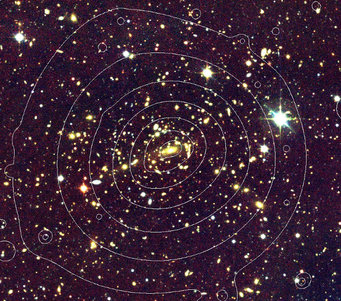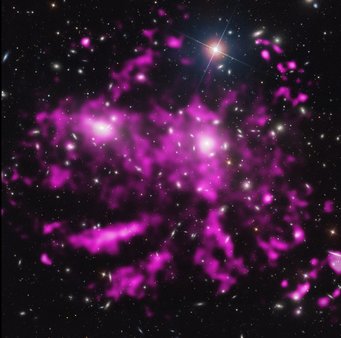Clusters and Groups of Galaxies
Galaxy clusters are the largest gravitationally-bound structures in the universe. As such, they are powerful tracers of the structures of matter on the largest scales, allowing us to measure the properties of the universe itself. In addition, they are fascinating cosmological laboratories for understanding the interaction of galaxies, gravity, plasmas, active galactic nuclei, supermassive black holes and star formation.

Galaxy clusters are dominated by dark matter, which makes up around 85 per cent of the total mass. Dark matter can only be detected by its gravitation effect on other matter and light passing near it. Most of the normal light-emitting matter is in the form of a hot plasma (a gas which is so hot that the electrons and nuclei do not stay bound together), the intracluster medium (ICM). Clusters contain 10s to 1000s of galaxies, which only make up around 2 per cent of their total mass. Galaxy clusters cover a range of mass, with the lowest mass end being known as galaxy groups.
The ICM is hot due to the massive potential well of galaxy clusters. The gravitational potential energy of material falling into the cluster leads to shock heating of the gas to 10s of millions of °C. Because of the size of clusters, this material is very tenuous, with only roughly between 10 and 10000 particles in each cubic metre of cluster. The density increases towards the centre of the cluster. The ICM emits X-rays strongly due to its high temperature via the Bremsstrahlung emission process, which emits with a brightness proportional to the density of the ICM squared.
In the High Energy (HE) Group we primarily study clusters by their X-ray emission, which is one of the most robust methods of finding clusters and examining their properties. Information from other wavebands also provides powerful independent methods to find clusters and verify their properties. This includes studying the number of galaxies and their velocity, as in more massive clusters there are more galaxies and these galaxies move faster due the gravitational field. Clusters also affect light from the cosmic microwave background travelling through the cluster via a process called the Sunyaev-Zel'dovich (SZ) effect, where the frequency of light is modified as it passes through the cluster. Another method is to examine the effect a cluster has on light from galaxies behind the cluster. The large mass of the galaxy cluster bends light passing through the cluster by a process called "gravitational lensing". Depending on how close the light travels to the mass, this can be a strong effect, giving characteristic arcs of light, or a weak, where the shapes of many galaxies are slightly distorted.
Cosmology Using Galaxy Clusters
The basic properties of the universe affect how clusters form and grow over their lifetimes. These properties include the expansion speed of the universe (H0), the fraction of the universe which is normal, rather than dark, matter (Ωm), the strength of a mysterious repellent force known as dark energy (ΩΛ) and the strength of the growth of fluctuations (σ8). Therefore we can measure the properties of the universe (do cosmology) by studying clusters.

The primary way this can be done is to count how many clusters there are of a particular mass as a function of the distance from us. As we look further away with telescopes we are also looking into the past of the universe, as light takes time to reach us. Therefore by counting clusters with particular ranges of mass and by looking at how they shape the 3-d large-scale structure, we study how clusters grow and evolve over the lifetime of the universe.
The HE group at MPE is taking a leading role in the construction of the eROSITA instrument on the Russian Spectrum-Roentgen-Gamma" (SRG) satellite, due to be launched in 2016. It will make several surveys of the sky in the X-ray band, allowing us to discover between 50 to 100 thousand clusters of galaxies, in addition to many other astronomical objects. Large spectroscopic and imaging surveys will complement the X-ray observations. Analyses of the optical light emitted by the 100-1000 galaxies they host will complement the survey by assessing the distance of the objects and the epoch at which they are observed. We will use this large sample of clusters to produce tight constraints on the cosmological properties of the universe.
Galaxy cluster astrophysics

Many physical processes are important in galaxy clusters. The physics of the dark matter is thought to be well understood, even though dark matter cannot be directly seen. The physics of gas and plasmas in clusters is poorly understood, however. For example, at the centre of clusters is often found an active supermassive black hole, or active galactic nucleus (AGN). These AGNs are thought responsible for preventing the rapid cooling of the ICM in the centre of the cluster. The process of matter being accreted by the black hole leads to highly energetic jets of material being squirted into the ICM, inflating giant bubbles of material and heating the surrounding gas. This is called AGN feedback, but many of the processes taking place are not yet understood. In addition, the ICM is believed to be turbulent. How much turbulence there is and what effect it has on the cluster is only poorly known. Other interesting physics to study is the enrichment of the ICM with "metals" (heavy elements, like oxygen, iron or silicon) produced by stars. The cluster acts as a reservoir of the metals produced by stars over its lifetime.
Studying cluster astrophysics is not only important for itself. The physical processes we observe in clusters also affects their ability to be used as probes of the cosmology. AGN feedback, for example, affects the overall ICM temperature and X-ray brightness of the cluster, two of the main methods for measuring cluster mass. Cluster physics also can affect our ability to find clusters.


